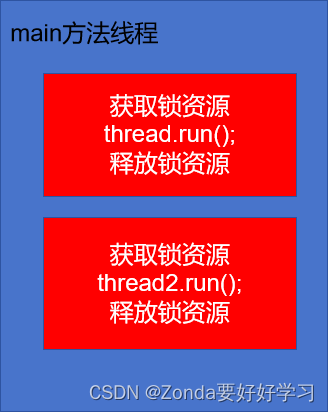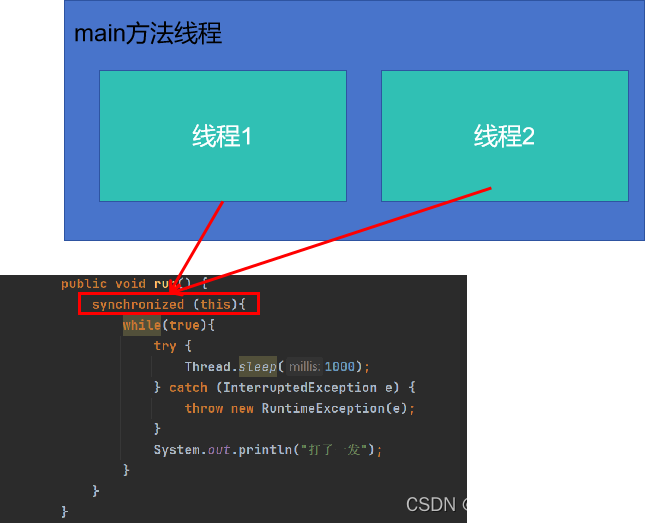我们知道,在多线程中
Thread thread = new Thread(runnable);
thread.start();以及 thread.run();都可以执行runnable中run方法下的代码,但是二者又有所不同
下面给出一段代码用以体现二者的区别:
以下代码中,通过thread.start()启动线程,最终产生了线程阻塞
package com.xuecheng;/*** @author Zonda* @version 1.0* @description TODO* @2024/6/15 16:23*/
public class ThreadLocal {public static void main(String[] args) {Runnable runnable = new Runnable() {@Overridepublic void run() {synchronized (this){while(true){try {Thread.sleep(1000);} catch (InterruptedException e) {throw new RuntimeException(e);}System.out.println("打了一发");}}}};Thread thread = new Thread(runnable);thread.start();Thread thread2 = new Thread(runnable);thread2.start();}
}但如果是调用run方法区启动就不会,这是为什么呢?
Thread thread = new Thread(runnable);thread.run();Thread thread2 = new Thread(runnable);thread2.run();
因为当我们直接调用run方法执行的时候,这是直接在main方法的主线程中调用run方法,并没有开启一个新的线程,因此 thread.run();和 thread2.run();会在main方法的主线程中顺序执行。这样就不会出现两个线程去争抢同一个锁中的资源的情况。

而执行start方法会在main线程中异步地开启一个新线程去执行run方法中的代码,如果有两个线程执行start方法,就会出现两个线程同时去执行run方法中的情况。如果一个其中一个线程休眠的时候另一个线程访问这个方法还好,可以交替访问;但是一旦出现一个线程在执行run方法的时候,另一个线程也同时要执行run方法,但是synchronized关键字中的元素只能被一个线程访问,最终会卡死。

我们通过阅读源码也可以看出只有在调用start方法的时候才会创建线程:
start0();
public synchronized void start() {/*** This method is not invoked for the main method thread or "system"* group threads created/set up by the VM. Any new functionality added* to this method in the future may have to also be added to the VM.** A zero status value corresponds to state "NEW".*/if (threadStatus != 0)throw new IllegalThreadStateException();/* Notify the group that this thread is about to be started* so that it can be added to the group's list of threads* and the group's unstarted count can be decremented. */group.add(this);
// 将当前线程对象添加到它的线程组。线程组是一种管理线程的机制,可以对线程进行分组管理。boolean started = false;try {start0();started = true;//start0();执行成功,走到这里说明线程创建成功} finally {try {if (!started) {group.threadStartFailed(this);}} catch (Throwable ignore) {/* do nothing. If start0 threw a Throwable thenit will be passed up the call stack */}}}private native void start0();


的作用)








)



)

-避免通配符导入)

】)